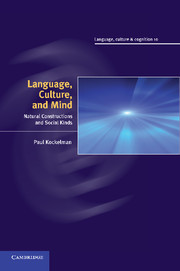Book contents
- Frontmatter
- Contents
- List of illustrations
- Acknowledgements
- 1 Language, culture, mind: emblems of the status human
- 2 Inalienable possessions: what hearts, mothers, and shadows have in common
- 3 Interclausal relations: how to enclose a mind by disclosing a sign
- 4 Myths about time and theories of mind: why the moon married the sun
- 5 Other minds and possible worlds: when psychological depth is dialogical breadth
- 6 Interjections: why the centre of emotion is at the edge of language
- 7 Conclusion: natural constructions and social kinds
- Appendix A Transcription conventions
- Appendix B The Marriage between the Sun and the Moon
- References
- Index
5 - Other minds and possible worlds: when psychological depth is dialogical breadth
Published online by Cambridge University Press: 04 May 2010
- Frontmatter
- Contents
- List of illustrations
- Acknowledgements
- 1 Language, culture, mind: emblems of the status human
- 2 Inalienable possessions: what hearts, mothers, and shadows have in common
- 3 Interclausal relations: how to enclose a mind by disclosing a sign
- 4 Myths about time and theories of mind: why the moon married the sun
- 5 Other minds and possible worlds: when psychological depth is dialogical breadth
- 6 Interjections: why the centre of emotion is at the edge of language
- 7 Conclusion: natural constructions and social kinds
- Appendix A Transcription conventions
- Appendix B The Marriage between the Sun and the Moon
- References
- Index
Summary
Grammatical categories and participant roles
Kant offered a classic definition of the principles of modality: they ‘add to the concept of a thing, of which otherwise they say nothing, the cognitive faculty from which it springs and in which it has its seat’ (1964 [1781]: 252). In some sense, Kant was making a distinction between signs that stand for objects and signs that stand for the signer's relation to those objects. If signs of the first type refer to and predicate qualities about a given state of affairs (e.g. my dog died), signs of the second type refer to and predicate qualities about the speaker's relation to a given state of affairs (e.g. I was sad that …). Indeed, the two kinds of signs (signs of mode events and signs of content events) are also true of noun phrases, as expressed in the idiom of primary and secondary properties: a beautiful green book. In this example, one kind of sign is relatively descriptive (focusing on the object: green) and the other kind of sign is relatively evaluative (focusing on the signer's relation to the object: beautiful). In certain constructions (such as those involving complement-taking predicates), where description ends (the complement) and evaluation begins (the predicate) is relatively easy to specify. But in other constructions (such as those involving interjections), description and evaluation are difficult to disentangle.
- Type
- Chapter
- Information
- Language, Culture, and MindNatural Constructions and Social Kinds, pp. 120 - 162Publisher: Cambridge University PressPrint publication year: 2010



